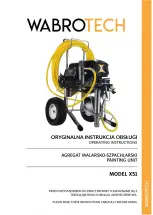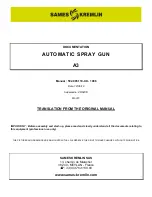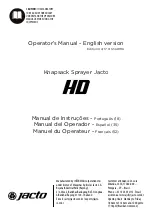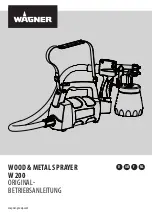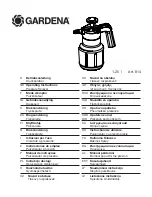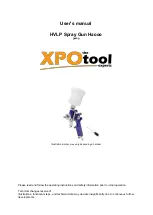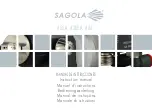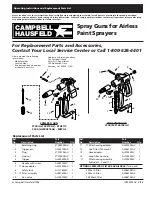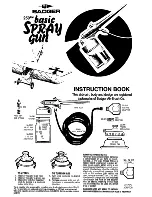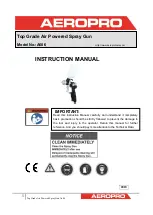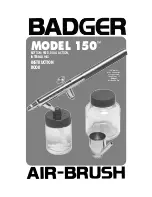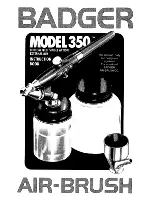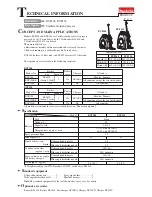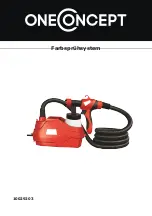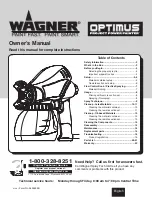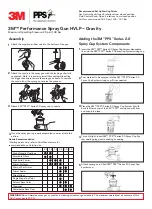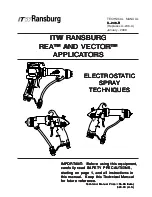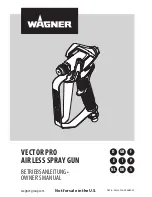
- 12 -
STARTING AND STOPPING
To start the appliance, press the ON/OFF switch
(3 Fig.A) to the ON position. With working motor
the pistol is constantly pumping out only air. To
obtain a paint outlet, press the gun trigger (11
Fig.A). To stop the appliance, release the gun
trigger to STOP the paint flow, then press the
ON/OFF switch to OFF to stop the engine.
OPERATING INSTRUCTION
After having read the safety standards carefully,
apply these tips scrupulously to obtain maxi-
mum performance from your machine. Work
calmly. You will only be able to make full use of
the machine’s potential after gaining sufficient
experience. The painting conditions provided by
this machine include a high volume of air that
directs the spray jet at low pressure, which pro-
vides greater painting efficiency. In addition the
stream of air shortens the drying time required
for the coating material.
The diagram in Fig.D illustrates the correct
position and use.
!
!
Warning! To ensure high efficiency of the
appliance and avoid overheating of the motor,
always keep the ventilation holes (22 Fig.A)
clean and free.
Preparing the item or surface to be coated.
The painting result depends on the cleanliness
and evenness of the surface to be painted.
Remove all traces of rust or old paint, and sand
down if necessary. Fill where necessary to pro-
vide an even surface. Remove all dust from the
surface before spraying. Read the instructions
on the paint tin carefully, to check whether it is
possible to apply a bonding agent before pain-
ting for better results and in order to use less
paint. Surfaces that are not to be painted are to
be masked using adhesive tape or newspaper.
Cover the floor with blankets.
Preparing the material to be sprayed.
Shake the tin well before opening. Generally the
paint to be used must be diluted (we suggest
testing a small amount of paint before diluting
the entire tin). Follow the paint manufacturer’s
indications relating to the type of diluents and
quantity to be added. If the manufacturer does
not indicate how their product is to be diluted or
what diluents to use, ask your paint dealer, being
sure to indicate that it will be applied using an
HVLP (high volume, low pressure) gun. Fill the
tank (12 Fig.A) for the gun to a maximum of ¾
of its capacity. If necessary, add small amounts
of diluents at a time after spraying test patches
on cardboard or a piece of wood. The degree
of dilution of the paint generally depends on
its viscosity. Dense paints are more viscous,
less dense paints are less. For an estimated
viscosity to be associated with paints, where
no specific information is provided on the paint
tin, see the table:
Coating material
Viscosity
(DIN-s)
Paints containing solvents
15-30
Basecoats
25-30
Mordants and primers
undiluted
2-component enamels and
oil paint
20-35
Transparent enamels
15-25
Water dilutable paints
20-25
Vehicle coatings
20-25
Timber sealers
undiluted
Wall paint
16-20
Using the viscosity meter (Fig. F)
This instrument indicates the viscosity in se-
conds. Mix the product and the diluents well. Fill
the viscosity meter (9 Fig.A) with the substance
to be sprayed and count the seconds the liquid
takes to flow out of the hole at the bottom alto-
gether (Fig. I). This period of time is the viscosity
expressed in DIN-seconds (DIN-s). Continue
trying various dilutions until the correct viscosity
(DIN-s) for the given product is reached.
Adjusting the spray gun (Fig. E).
Make sure that the air hose is unrolled and not
twisted and that the end connectors are tightly
clamped to the gun and body and to the hose
itself to avoid pressure losses (see section Ma-
king In Service). Make sure that the paint suction
pipe (19 Fig.A) is well tightened to the gun and is
in the direction that ensures complete emptying
of the tank (Fig. E4). Adjust the direction of the
paint output flow (Fig E1) By unscrewing the
gun ring (20 Fig. A) by rotating the butterfly
nozzle (21 Fig. A) to the desired position and

















